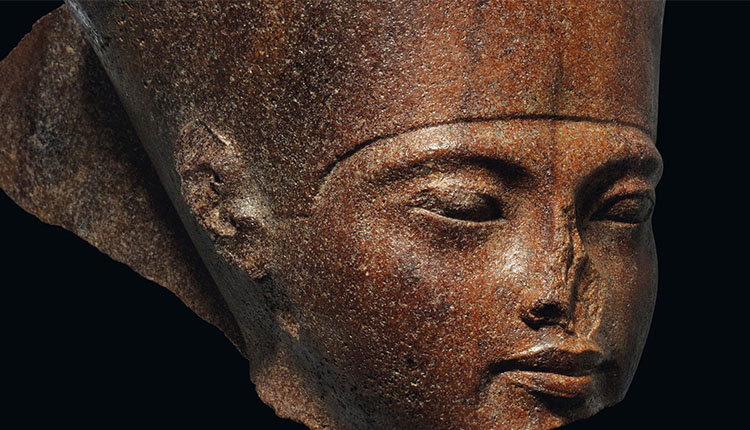Egypt trying to halt Tutankhamun statue sale in London
Egypt has moved to try and halt the sale of a 3000-year-old stone statue of King Tutankhamun, planned to take place at Christie’s auction house next month after concerns were raised that the bust might have been stolen from the Karnak temple in Luxor.
The brown quartzite head of Tutankhamun is expected to fetch more than £4 million (Dh18.64m) when it goes on sale at Christie’s on July 4.
The Egyptian ministry said it had asked the British Foreign Office and the auction house to halt the sale and return the artefact to the country through Egypt’s embassy in London.
“If it’s proven that any piece has been illegally moved out of the country, we will take legal action with Interpol,” the ministry said.
“We will never allow anyone to sell any ancient Egyptian artefact.”
A former Egyptian minister of antiquities said he believed the statue had been taken illegally from an ancient site known as Karnak Temple, in the southern city of Luxor.
“It seems that this sculpture was looted from Karnak Temple,” Dr Zahi Hawass told ABC News. “Christie’s would not have any proof whatsoever of its ownership.”
Christie’s said any accusation that it had procured the artefact illegally was untrue and that the present lot was part of the Resandro Collection, which it described as “one of the world’s most renowned private collections of Egyptian art”.
The auction house said it had acquired the lot, which also includes an Egyptian coffin and bronze Egyptian cat statue, from Munich dealer Heinz Herzer in 1985.
Before this, Joseph Messina, an Austrian dealer, acquired it in 1973-74 from Prinz Wilhelm von Thurn und Taxis who reportedly had it in his collection by the 1960s.
“Ancient objects by their nature cannot be traced over millennia,” Christie’s said. “It is hugely important to establish recent ownership and legal right to sell, which we have clearly done.
“We would not offer for sale any object where there was concern over ownership or export. The work has been widely exhibited and published and we have alerted the Egyptian embassy so they are aware of the sale.
“There is a long-standing and legitimate market for works of art of the ancient world, in which Christie’s has participated for generations.
“Christie’s strictly adheres to bilateral treaties and international laws with respect to cultural property and patrimony.”
Dr Shaaban Abdel-Gawad, the head of the anti-smuggling department at Egypt’s ministry of antiquities, said in a statement that officials were “studying the auction files in preparation for taking the necessary measures”. The ministry also reiterated Egyptian officials’ demand for documents showing proof of ownership.
Egypt has stepped up its fight against the sale of looted antiquities worldwide. Abdel-Gawad’s office often leads the way by monitoring auction sites, whose listings often alert the authorities to the presence of treasures sometimes removed from the country decades earlier.
“If it is proven that any piece is illegally exported, all legal procedures are taken with Interpol, in coordination with the Egyptian ministry of foreign affairs in order to ensure its return,” said Abdel-Gawad. “We will not tolerate or allow anyone to sell Egyptian influence at all.”
Christie’s says the statue will be auctioned from the private Resandro collection in July, in a sale that includes marble heads dating from ancient Rome, a painted wooden Egyptian coffin, and a bronze Egyptian cat statue.
“The present lot was acquired from Heinz Herzer, a Munich-based dealer in 1985. Prior to this, Joseph Messina, an Austrian dealer, acquired it in 1973-74 from Prinz Wilhelm von Thurn und Taxis, who reputedly had it in his collection by the 1960s,” the auction house said.
A spokeswoman for Christie’s defended the sale. “Ancient objects by their nature cannot be traced over millennia,” she said. “It is hugely important to establish recent ownership and legal right to sell which we have clearly done. We would not offer for sale any object where there was concern over ownership or export.”
She said the statue was previously widely exhibited, and that Christie’s informed the Egyptian embassy in London before the sale. “There is a longstanding and legitimate market for works of art of the ancient world, in which Christie’s has participated for generations. Christie’s strictly adheres to bilateral treaties and international laws with respect to cultural property and patrimony,” she said.
Waziri said: “Christie’s can say whatever they like. But I’ve seen pictures of the head and I have to check. If we can get better pictures, I can say if it’s similar to the ones in Karnak or not. I can’t say anything until I see the head itself.”



